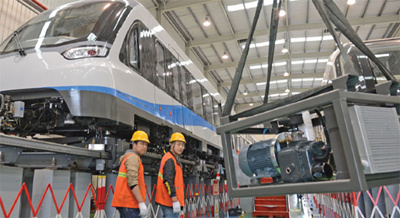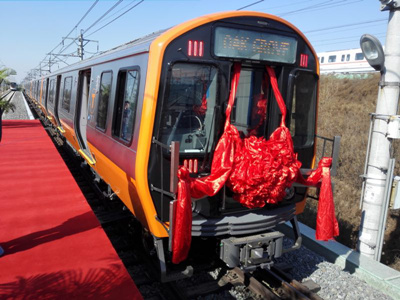Full coverage: China Breakthroughs
By Tom McGregor, CCTV.com Panview commentator and editor
The CRRC (China Railway Rolling-stock Corporation) Ltd., the world’s largest train equipment manufacturer, has constructed massive rail networks all across the globe and continues to upgrade its train technology setting for higher speeds, while ensuring greater safety and comfort for passengers.
The state-owned railway firm has launched commercialized trains for carrying passengers and freight. The company hopes to construct maglev train lines that could reach speeds at over 600 kilometers/hour (km/h), or 372.8 miles per hour (mph) in the near future.

(A maglev train manufacturing company in Zhuzhou, Hunan province. Photo from China Daily by Xu Jing)
But before super-fast trains can get built at full-functionality, engineers are required to test-run slower trains and then develop and equip them for higher speeds.
In early October 2017, the Beijing Maglev Corporation announced that they would soon start trial operations of the first medium low speed maglev to run in the Chinese capital city.
The company has conducted successful testing and scheduled to open up a 10.2-km S-1 line running between the western suburb districts - Mentougou and Shijingshan.
Defining a Maglev Train
Maglev trains are built for speed, since the wheels do not touch the tracks, because magnets and electric currents cause the train to levitate while in motion. Smooth gliding creates more comfort for passengers as well.
Chinese railways technology companies and engineers are conducting extensive research to learn more about the science of levitation and traction technologies to develop new Chinese homegrown maglev trains, which are intended for use at home and abroad. Many of those involved with R&D (research and development) have received substantial funding from the CRRC.
Tracks for test-runs
China's top two cities - Beijing and Shanghai - stand 1,088km. apart, but they are connected by a bullet train that reaches speeds up to 350km/h, with a one-way trip duration time lasting around five hours. If a maglev train can be completed, that could reduce travel time by another two hours.
In Oct. 2016, the CRRC outlined plans to construct a 5km-long maglev track for test-running new models. Currently, they operate maglevs that just run at a maximum speed of 200km/h on a track, which connects Shanghai’s Central Business District (CBD) and Pudong International Airport.
For the moment, Japanese train companies are considered global leaders in the maglev technology field, but CRRC appears poised to catch up and surpass them. The Chinese company constructed its first homegrown maglev line in Changsha, capital of central China's Hunan Province, to transport passengers between its south railway station and the local airport.
The planned track is expected to test different track gauges to ensure crossing borders that would be more efficient, while supporting new technologies, which can be energy conscious.
Opening up China Pan Asia Railways
As of the end of 2016, China’s total construction of hi-speed rail networks had reached nearly 22,000-km, a length span stretching halfway across the world. Additionally, major new railway projects are under construction throughout Asia, Europe, the Middle East, South America and Africa with negotiations under way to expand the railways in major cities in North America.

(The first batch of subway trains manufactured by China for the Boston subway's new Orange Line is expected to be shipped to the city in December, announced the manufacturer, CRRC Changchun Railway Vehicles on Oct 16. Photo from China Daily by Ding Luyang)
The CRRC intends to complete tracks worldwide, 30,000km by 2020 and 45,000km by 2030. They continue to bid for other high-speed rails projects in the United Kingdom, Australia, Southeast Asia, Iran, Thailand and Mexico.
The company had opened its regional headquarters in Southeast Asia, known as China Pan Asia Railways, in Bandar, Malaysia, located near Kuala Lumpur.
"If ASEAN (Association of Southeast Asian Nations) can work together under China's New Silk Road policy and we can link up our rail and port infrastructure with China, there’s a lot of advantages," Malaysia's 2nd Minister for International Trade & Industry Ong Ka Chuan told ChannelNewsAsia.
The CRRC opened its first ‘railways factory’ in Batuh Gajah, Malaysia in Aug. 2015.
Going underground: deeper and bigger
China has embarked on bold plans for its railways. The CRRC is making them bigger, faster and safer, while developing more underground tracks and train stations.
The CRRC is building the world's largest and deepest railway station where contractors are expected to dig underneath the famed Great Wall of China, Badaling section.
Chen Bin, director of the construction project, said the underground station would be 335ft. below surface, covering an area the size of five soccer fields.
The site upon completion will link China's capital city with Zhangjiakou, a co-host for the upcoming 2022 Winter Olympic Games.
Excavators would utilize state-of-the-art equipment and explosives in order to avoid harming the Great Wall. Construction is not expected to interrupt the free flow of over ten million visitors, who come to the area annually.
Chinese developers have taken tremendous strides to construct underground tunnels and stations in major cities nationwide.
Seeking safer and faster maglevs
China is building faster trains and perhaps about a decade later, passengers could ride maglevs that can run at over 1,000km/h. Nevertheless, safety should take top priority.
Passengers love to ride fast trains, but they should not have to fear for their lives just to ride them. The CRRC must continue to conduct extensive testing on maglev trains, and ask, "how can we build even safer and faster trains?"
Apparently, Beijing has already enforced rigorous safety standards to keep Chinese trains running for comfort and at top speeds.
(The opinions expressed here do not necessarily reflect the opinions of Panview or CCTV.com. )

Panview offers a new window of understanding the world as well as China through the views, opinions, and analysis of experts. We also welcome outside submissions, so feel free to send in your own editorials to "globalopinion@vip.cntv.cn" for consideration.
















